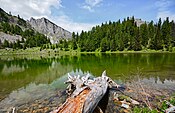Geography of Kosovo
 | |
| Continent | Europe |
|---|---|
| Region | Southeast Europe (Balkans) |
| Area | |
| • Total | 10,887 km2 (4,203 sq mi) |
| • Land | 99% |
| • Water | 1% |
| Coastline | 0 km (0 mi) |
| Borders |
|
| Highest point | Gjeravica 2,656 m (8,714 ft) |
| Lowest point | White Drin 297 m (974 ft) |
| Longest river | White Drin 122 km (76 mi) |
| Largest lake | Lake Ujman 9.2 km2 (4 sq mi) |
| Climate | Temperate Zone Continental and Mediterranean |
| Terrain | Mountains, Hills, Forest, urban |
The country possesses impressive and contrasting
The country is a quite rich country for its
The climate of the country is mostly defined by its geographical location in the southeastern part of the
Kosovo is characterised by rich
Territory
Borders
The
The border between Kosovo and
Physical geography
Topography
The country of
Most of the country is mountainous and hilly. The southern and southeastern edge is distinguished by the Sharr Mountains.
The
Hydrography
A landlocked country, there are several notable rivers and lakes within the country's borders. The drainage basin of the Black Sea comprises 50.7 percent of the territory of the country and totals 5,520 square kilometres (2,130 sq mi), which makes it the largest in Kosovo.[15] The main rivers in the section of the country of the river basin are the rivers of Ibar and Sitnica.
In contrast, 43.5 percent of the country's territory is encompassed by the drainage basin of the
The
A number of natural lakes are located in the mountain ranges at various altitudes amongst them the
The main lakes are
Biodiversity
Kosovo is characterised by a diverse
In terms of phytogeography, the land area of Kosovo lies within the Boreal Kingdom, specifically within the Illyrian province of the Circumboreal Region. Its territory can be conventionally subdivided into four terrestrial ecoregions of the Palearctic realm, amongst them the Balkan and Dinaric mixed forests.
Kosovo is particularly rich in remote and mountainous landscapes endowed with
The country has only two designated
Climate
Kosovo is located between the
The climatic area of the
Extreme points
Elevation
- Highest point: Gjeravica, at 2,656 m (8,714 ft) m, 42°32′1″N 20°08′24″E / 42.53361°N 20.14000°E, Deçan, District of Peja[25]
- Lowest point: White Drin Valley near the border with Albania, at 297 m (974 ft), 42°9′45.7″N 20°32′43″E / 42.162694°N 20.54528°E, Vërmicë, Prizren[26]
See also
References
- ^ Gani Gashia, Florim Isufi, Shpejtim Bulliqia, Ibrahim Ramadania. "Correlation between discharge, river Basin surface and rainfall quantity in Kosova" (PDF). publisher-connector.core.ac.uk. pp. 1–5. Archived from the original (PDF) on 2017-09-23. Retrieved 2018-09-21.
Kosovo waters flows towards the Adriatic, Aegean and Black Sea.
{{cite web}}: CS1 maint: multiple names: authors list (link) - ^ "Kosovo Biodiversity Assessment" (PDF). ww.ammk-rks.net. pp. 1–66.
- ^ [1], CIA - The World Factbook
- ^ Ministria e Punëve të Brendshme e Kosovës. "STRATEGJIA KOMBËTARE E REPUBLIKËS SË KOSOVËS PËR MENAXHIMIN E INTEGRUAR TË KUFIRIT" (PDF). mpb-ks.org (in Albanian). pp. 1–93.
- ^ "SHARR/ŠAR PLANINA – KORAB – DEŠAT/DESHAT" (PDF). envsec.org. pp. 1–132.
- ^ Zeqir Veselaj (2010). "Bjeshkët e Nemuna perla natyrore e Kosovës" (PDF). documents.rec.org (in Albanian). pp. 29–32.
- ^ Ministria e Mjedisit dhe Planifikimit Hapësinor - Instituti i Kosovës për Mbrojtjen e Natyrës. "STUDIM MBI ARSYESHMËRINË E SHPALLJES SË TERRITORIT TË BJESHKËVE TË NEMUNA PARK NACIONAL" (PDF). ammk-rks.net (in Albanian). pp. 13–14.
- ^ "PËR PARKUN KOMBËTAR "BJESHKËT E NEMUNA"" (PDF). ammk-rks.net (in Albanian).
- ^ "PËR PARKUN KOMBËTAR "SHARRI"" (PDF). ammk-rks.net (in Albanian).
- ^ "Qenan Maxhuni: Biodiversiteti i Kosoves" (PDF) (in Albanian). AKMM/IKMN. Archived (PDF) from the original on 3 March 2016. Retrieved 23 February 2013.
- ^ "VLERAT E TRASHËGIMISË NATYRORE TË KOSOVËS" (PDF). ammk-rks.net (in Albanian). 2005.
- ^ "Shala e Bajgores Nė Vėshtrim Historik". Archived from the original on 2018-07-25. Retrieved 2015-06-04.
- ^ Mermerna Pecina Archived 2008-05-22 at the Wayback Machine, Tony Oldham, 2002
- ^ Around Kosovo: It's Better to See it Once Than Hear About it 100 Times, Valerii Petrushka
- ^ a b c Ministria e Mjedisit dhe Planifikimit Hapësinor - Instituti i Kosovës për Mbrojtjen e Natyrës (2010). "Report The State of Water in Kosovo R" (PDF). ammk-rks.net. Prishtina. pp. 31–39.
- ^ [2] Archived 2015-04-03 at the Wayback Machine Independent Commission for Mines and Minerals of Kosovo
- ^ a b "Kosovo Biodiversity Assessment" (PDF). ammk-rks.net. 2003. pp. 1–66.
- ^ "Brown Bear Conservation Action Plan for Europe" (PDF). nina.no.
- ^ "Action Plan for Grey Wolf Canis lupus Conservation and Management" (PDF). daba.gov.lv. 2017.
- ^ "STATSU AND DISTRIBUTION OF THE BALKAN LYNX (Lynx lynx martinoi MIRIĆ, 1978) AND ITS PREY" (PDF). catsg.org.
- ^ "Overview of Nature Protection Progress in Kosovo" (PDF). landscapeonline.de (in Albanian). p. 6. Archived from the original (PDF) on 2017-10-20. Retrieved 2018-09-21.
- ^ "Geography". Archived from the original on 2013-06-21. Retrieved 2008-09-08.
- ^ Strahler & Strahler. (2006).Introducing Physical Geography, Boston:John Wiley & Sons Inc.
- ^ "Climatic Conditions". Archived from the original on 2014-05-27. Retrieved 2014-05-27.
- ^ "Kosovo | History, Map, Flag, Population, Languages, & Capital | Britannica". www.britannica.com. 2023-11-22. Retrieved 2023-11-25.
- ^ "Kosovo Geography – Be In Kosovo". Retrieved 2023-11-25.


